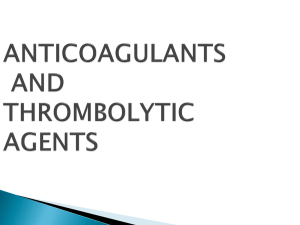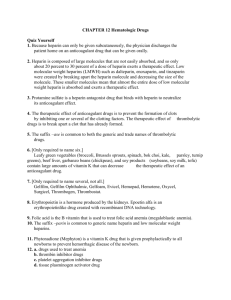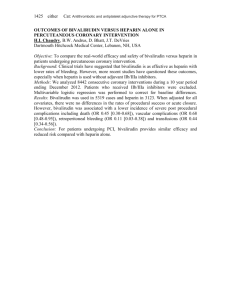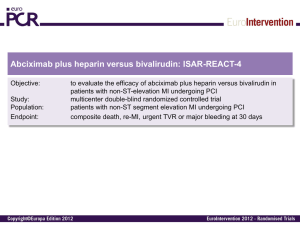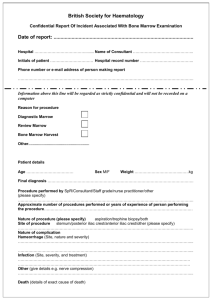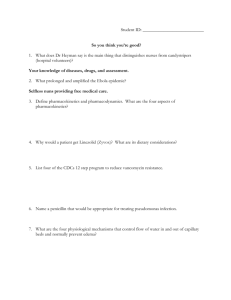10. Drugs Affecting Blood and Blood Formation
advertisement
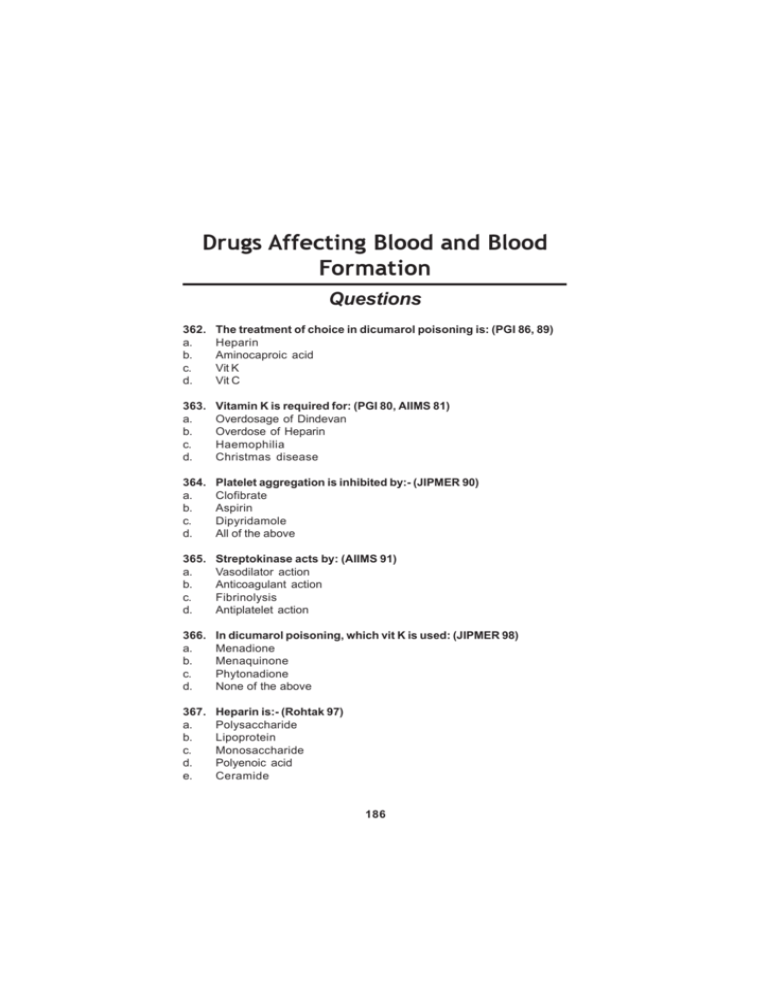
186 Pharmacology Drugs Affecting Blood and Blood Formation Questions 362. a. b. c. d. The treatment of choice in dicumarol poisoning is: (PGI 86, 89) Heparin Aminocaproic acid Vit K Vit C 363. a. b. c. d. Vitamin K is required for: (PGI 80, AIIMS 81) Overdosage of Dindevan Overdose of Heparin Haemophilia Christmas disease 364. a. b. c. d. Platelet aggregation is inhibited by:- (JIPMER 90) Clofibrate Aspirin Dipyridamole All of the above 365. a. b. c. d. Streptokinase acts by: (AIIMS 91) Vasodilator action Anticoagulant action Fibrinolysis Antiplatelet action 366. a. b. c. d. In dicumarol poisoning, which vit K is used: (JIPMER 98) Menadione Menaquinone Phytonadione None of the above 367. a. b. c. d. e. Heparin is:- (Rohtak 97) Polysaccharide Lipoprotein Monosaccharide Polyenoic acid Ceramide 186 Drugs Affecting Blood and Blood Formation 368. a. b. c. d. 187 Not true about heparin is: (PGI 98) Activates antithrombin III Small unionized molecule are not absorbed orally Protamine sulphate always used to reverse its action Release lipoprotein lipase from vessel wall & tissues 369. The tissue plasminogen activator produced by recombinant DNA technology is: (JIPMER 2002) a. Anestreplase b. Reteplase c. Altepase d. Abciximab 370. a. b. c. d. Abciximab acts through: (MANIPAL 01) TXA inhibitor ADP related inhibitor 2b/3a receptor antibody Fibrinogen degradations 188 Pharmacology Drugs Affecting Blood and Blood Formation Answers 362. (c) Vit K Ref: KDT 5th/e pg 565 Bleeding as a result of extension of desired pharmacological action of Dicumarol is the most important problem : ecchymosis, epistaxis, hematuria, bleeding in GIT, intracranial or other internal haemorrhages may be fatal. Treatment :♦ Withhold anticoagulant ♦ Give fresh blood transfusion : supplies clotting factors & replenishes lost blood. Alternatively fresh frozen plasma can be used ♦ Vit K : specific antidote, but it take 6-24 hrs for the clotting factor to be resynthesized & released in blood after vit K administration 363. (a) Overdose of dindevan Ref: KDT 5th/e pg 565 Dindevan is a phenindione : Overdosage of this drug cause bleeding as a result of extension of desired pharmacological action, the most important problem: ecchymosis, epistaxis, hematuria, bleeding in GIT; intracranial or internal haemorrhages may be total Vit K acts as a specific antidote in treating such pts, it takes 6-24 hrs for the clotting factors to be resynthesized & released in blood after Vit K administration. 364. (b) Aspirin (c) Dipyridamole Ref: KDT 5th/e pg 572, 580 Aspirin at low doses, TxA2 formation by platelets is selectively suppressed Aspirin inhibits release of ADP from platelets & their sticking to each other. Dipyridamole inhibits phosphodiesterase & blocks uptake of adenosine to increase platelet (ANIP which potentiates PGI2 & interferes with aggregation levels of Tx A2 or PGI2, are not altered but platelet survival time reduced by disease is normalized Dipyridamole has also been used to enhance antiplatelet action of aspirin 188 Drugs Affecting Blood and Blood Formation 189 365. (c) Fibrinolysis Ref: KDT 5th/e pg 569 Streptokinase belongs to fibrinolytic group of drugs, these drugs lyse thrombi / clot to recanalyse occluded blood vessels Streptokinase obtained from beta-haemolytic streptococci & Group C Combines with circulating plasminogen to form a complex which breaks plasminogen to plasmin Plasmin further causes fibrinolysis Streptokinase in antigenic, antibodies are produced against it after streptococcal infection or drug used 366. (c) Phytonadione Ref: KDT 5th/e pg 559 To reverse the effect of overdose of oral anticoagulants: Phytonadione (K1) is the preparation of choice, because it acts most rapidly, dose depends on the severity of upoprothrombinemia & bleeding.Unnecessary high dose is to be avoided because it will render the patient unresponsive to oral anticoagulants for several days Severe : 10mg i.m followed by 5mg 4 hourly, bleeding generally stops in 6-12 hrs, but normal levels of coagulation factor are restored only after 24hr. This dose of Vit K will block anticoagulant action for 710 days Moderate : 10mg i.m followed by 5mg once or twice according to response Mild : Just omit a few doses of the anticoagulant. 367. (a) Polysaccharide Ref: KDT 5th/e pg 561 Heparin is a non-uniform mixture of straight chain mucopolysaccharide with MW 10,000 to 20,000. It contains polymers of two sulfated disaccharide units: D - Glucosamine - L-iduronic acid D - Glucosamine - D - Glucuronic acid It carries strong electronegative charges & is the strongest organic acid present in the body It occurs in mast cell as a much bigger molecule, loosely bound to granular protein. Thus, heparin is present in all tissues containing mast cells, richest sources are lungs, liver & intestinal mucosa. 368. (b) Small unionized molecule are not absorbed orally Ref: KDT 5th/e pg 561 for a, 562 for b, 564 for c, 562 for d Heparin acts indirectly by activating plasma antithrombin III. Heparin AT III complex then binds to clotting factors of the intrinsic 190 Pharmacology & common pathways & inactivates them but not factor VII a operative in the extrinsic pathway. The anticoagulant action is exerted mainly by inhibition of factor Xa as wells as thrombin (11a) mediated conversion fibrinogen to fibrin Low concentrations of heparin prolong PTT without significantly prolonging PT. High concentrations prolong both. Heparin at higher doses inhibits platelet aggregation & prolongs bleeding time Heparin clears turbid post-prandial lipemic plasma Heparin releases a lipoprotein lipase from the vessel wall & tissues, which hydrolyses triglycerides of chylomicron & very low density lipoproteins to free fatty acids, these then pass into tissue & the plasma looks clear. This action requires lower concentration of heparin than that needed for anticoagulation. Heparin is a large, highly ionized molecule, therefore not absorbed orally Heparin does not cross blood brain barrier or placenta Protamine sulfate given IV neutralizes heparin weight for weight. However it is needed in frequently because the action of heparin disappears by itself in few hours 369. (c) Altepase Ref: KDT 5th/e pg 570 Altepase Altepase is a recombinant tissue plasminogen activator (rt-PA), produced by recombinant DNA technology from human tissue culture, it specifically activates gel phase plasminogen already bound to fibrin & has little action on circulating plasminogen It is non antigenic, but nausea, mild hypotension & fever may occur 370. (c) 2b/3a receptor antibody Ref: KDT 5th/e pg 573 Abciximab Fab fragment of a chimeric monoclonal antibody against GP II b/III a Given along with aspirin + heparin during PTCA it has markedly reduced the incidence of restenosis, subsequent MI & death Abciximab is nonantigenic, the main risk is haemorrhage, incidence of which can be reduced by carefully managing the concomitant heparin therapy, thrombocytopenia is another complication. Constipation, ileus & arrhythmias can occur


